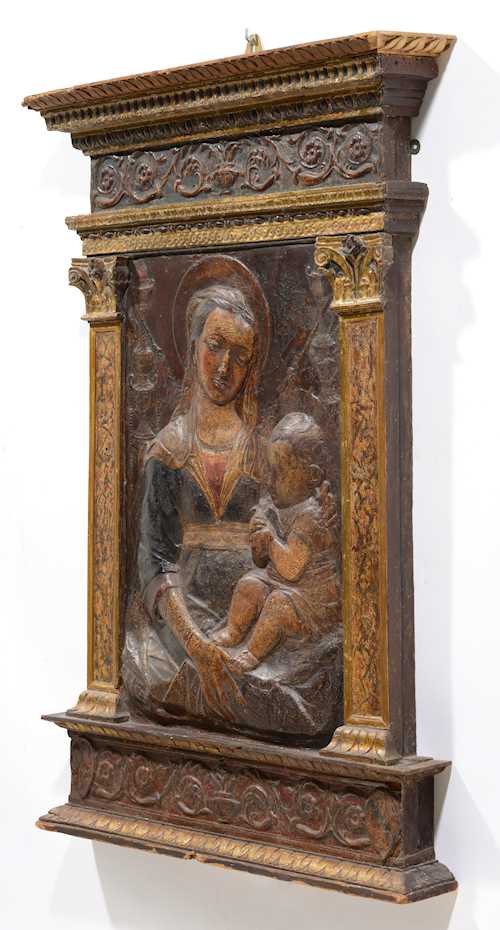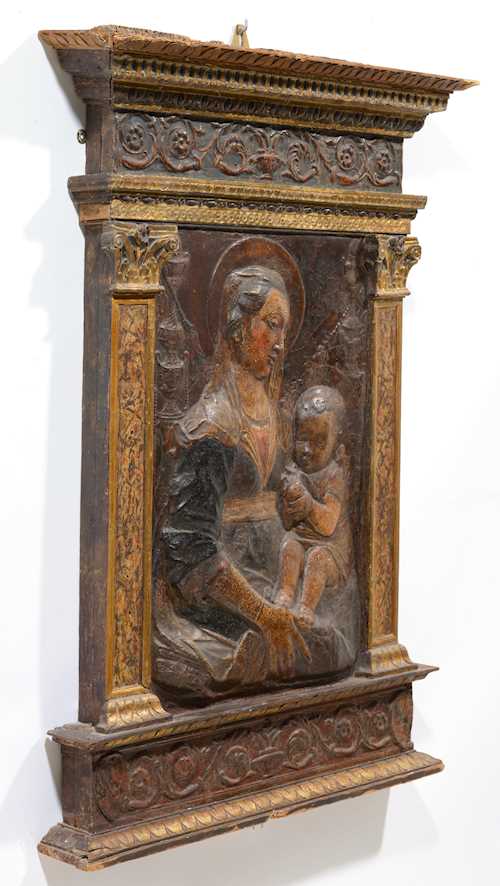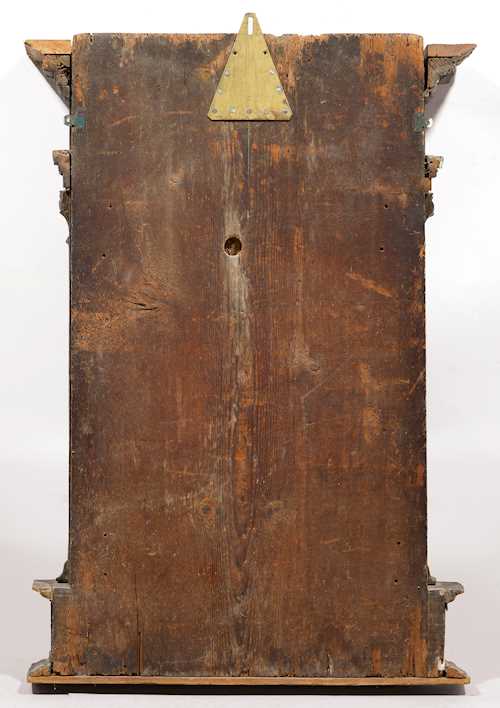
Lot 4215 - ibid138 Sculpture & Various - online only - Tuesday, 26. September 2023, 12.00 AM
STUCCO RELIEF "MADONNA DEI CANDELABRI"
Renaissance style, 19th century. Copy after Antonio Rossellino (1427/1428-1479).
Stucco, painted and parcel-gilt, in a carved Renaissance tabernacle frame decorated with scrolled leaves and leaf friezes. Figure in relief of a seated Madonna looking to the right, the Christ Child is sitting on a cushion placed on her knees and holds a bird in his hands. In the background: two burning candelabras and a garland. Strings of beads hang down from the candelabras.
Total 112 × 77.5 cm, relief 67 × 46 cm.
Provenance: Private collection, Suisse romande, from the Château de Courtaney à Avry, Fribourg.
The present composition with the convention name "Madonna dei Candelabri" originally goes back to the Florentine sculptor Antonio Rossellino (1427/28-1479) and seems to have enjoyed enormous popularity in the 15th century, as evidenced by numerous copies until the 19th century. Some partly painted terracotta examples of Rossellino's workshop can be seen today in the Museo Nazionale del Bargello in Florence and in San Jacopo alla Cavallina, in the Museo Correr in Venice and in the Victoria & Albert Museum in London (Inv. Nos. 7365-1861). Other stucco works are exhibited in Berlin in the Kaiser-Friedrich-Museum, in the Reggia Emilia (Contrada dell'Asineria) and in Paris in the Musée Jacquemart André. Antonio Rossellino belonged to the same impulsive Renaissance generation of artists as Desiderio da Settignano and Mino da Fiesole. His work also shows parallels with these two sculptors, even more than with the work of his brother, from whom he received his formal training.
Cf. Ronald G. Keck "Madonna und Kind. Das häusliche Andachtsbild im Florenz des 15. Jahrhunderts", Berlin, 1988, p. 63, 102, fig. 120.
The present composition with the convention name "Madonna dei Candelabri" originally goes back to the Florentine sculptor Antonio Rossellino (1427/28-1479) and seems to have enjoyed enormous popularity in the 15th century, as evidenced by numerous copies until the 19th century. Some partly painted terracotta examples of Rossellino's workshop can be seen today in the Museo Nazionale del Bargello in Florence and in San Jacopo alla Cavallina, in the Museo Correr in Venice and in the Victoria & Albert Museum in London (Inv. Nos. 7365-1861). Other stucco works are exhibited in Berlin in the Kaiser-Friedrich-Museum, in the Reggia Emilia (Contrada dell'Asineria) and in Paris in the Musée Jacquemart André. Antonio Rossellino belonged to the same impulsive Renaissance generation of artists as Desiderio da Settignano and Mino da Fiesole. His work also shows parallels with these two sculptors, even more than with the work of his brother, from whom he received his formal training.
Cf. Ronald G. Keck "Madonna und Kind. Das häusliche Andachtsbild im Florenz des 15. Jahrhunderts", Berlin, 1988, p. 63, 102, fig. 120.
CHF 4 000 / 6 000 | (€ 4 120 / 6 190)
Sold for CHF 3 750 (including buyer’s premium)
All information is subject to change.



